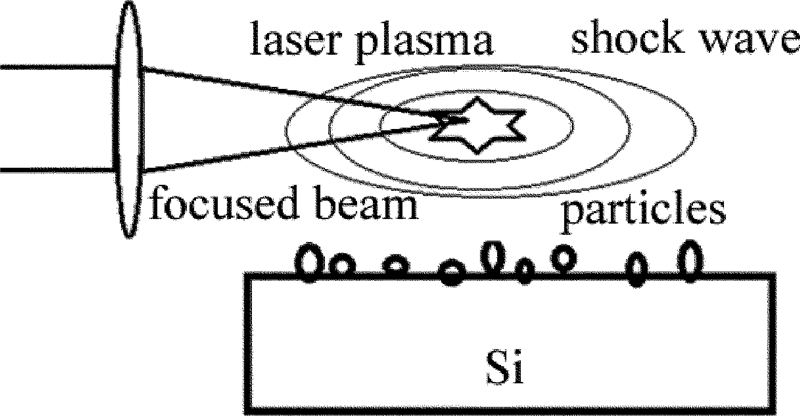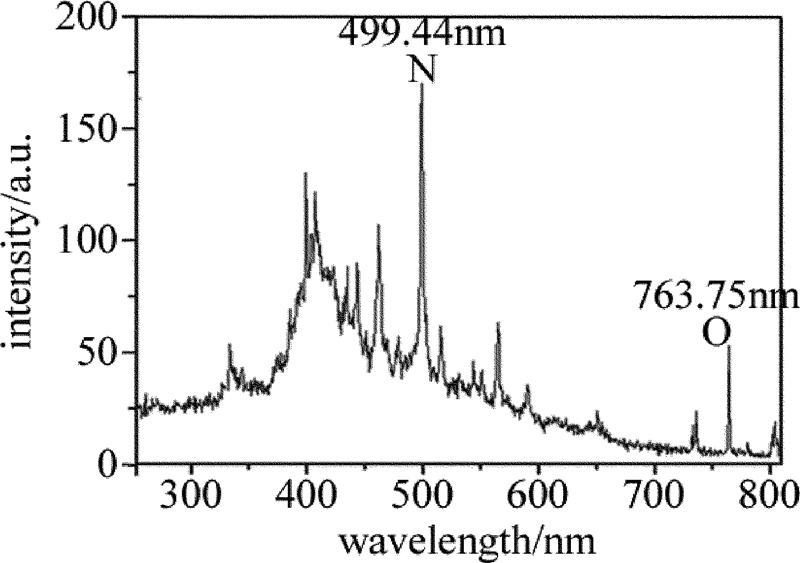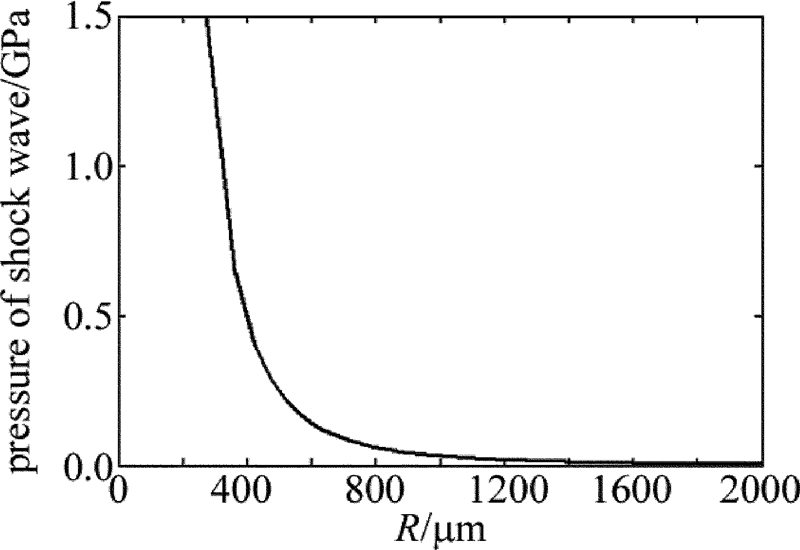Study on removal mechanism of micro-/nano-particles on silicon surface by laser plasma
-
摘要: 激光等离子体对精密元件表面微纳米粒子的有效去除,在纳米科研领域中有很大的应用潜力。为了深入研究激光等离子体对微粒的去除机理和条件,采用纳秒脉冲激光等离子体,对硅基底表面的微纳米粒子进行去除实验,观测了微粒的去除效果,并理论分析了等离子体的作用效应。结果表明,等离子体向外辐射宽谱光,紫外短波部分加速周围空气电离,使等离子体体积剧增,并有效提升基底和粒子温度;基底与粒子两者热膨胀度不同,使粒子更易于从基底剥离;同时等离子体向周围膨胀扩散形成高压冲击波,冲击波的压强高达GPa量级,可以克服微粒与基底之间的范德华力,而去除微纳米粒子,尤其对粒径大于0.5μm的去除效果尤其明显;在实际去除过程中,等离子体与基底的距离应该保持在0.2mm~2mm之间,这样既保证了微粒的有效去除,又不会造成基底的损伤。激光等离子体对微粒的去除效果明显,是等离子体辐射效应和冲击波效应的综合作用的结果。Abstract: Laser-induced plasma has shown increasing potential in removing micro-/nano-particles stuck onto the surface of precise components in nano-science and nano-technology. In order to study the removal mechanism of the micro-/nano-particles, silicon surfaces were cleaned by means of nanosecond laser plasma, during which the removal results was observed and then the optimized conditions for laser plasma to flush the silicon surface was recommended. The results show that plasma radiates out wide-spectrum light, whose ultraviolet short wave accelerates the ionization of surrounding air, increases the volume of plasma and increase the temperature of base and particle effectively. Because of thermal expansion difference between the base and particles, the particles are peeled from the base easily. At the same time, the high pressure shock waves up to GPa are formed resulting from the expansion and diffusion of plasma to the surrounding area. It can overcome van Edward force between the particles and the substrate and remove the micro-/nano-particles. Especially, the removal effect of the particle size larger than 0.5μm is more obvious. During the actual removal process, the distance from the plasma to the base should be between 0.2mm and 2mm. The distance can ensure the effective removal of the particles and cause no damage to the base. The effect of laser plasma on the removal of particles is obvious and it is the combined effect of the radiation effect and the shock wave effect of the plasma.
-
-
-
[1] NG D, HUANG P Y, JENG Y R, et al. Nanoparticle removal mechanisms during post-CMP cleaning[J]. Electrochemical and Solid-State Letters, 2007, 10(8):H227-H231. DOI: 10.1149/1.2739817
[2] ANDREEV V A, FREER E M, de LARIOS J M, et al. Silicon-wafer cleaning with aqueous surfactant-stabilized gas/solids suspensions[J]. Journal of the Electrochemical Society, 2011, 158(1):H55-H62. DOI: 10.1149/1.3503572
[3] TSUNEMI A, HAGIWARA K, SAITO N, et al. Complete removal of paint from metal surface by ablation with a TEA CO2 laser[J]. Applied Physics, 1996, A63(5):435-439. DOI: 10.1007/BF01571670
[4] VARGHESE I, CETINKAYA C. Non-contact removal of 60nm latex particles from silicon wafers with laser-induced plasma[J]. Journal of Adhesion Science and Technology, 2004, 18(7):795-806. DOI: 10.1163/156856104840327
[5] KRUUSING A. Underwater and water-assisted laser processing:part 1-general features, steam cleaning and shock processing[J]. Optics and Lasers in Engineering, 2004, 41(2):307-327. DOI: 10.1016/S0143-8166(02)00142-2
[6] CETINKAYA C, PERI M D M. Non-contact nanoparticle removal with laser induced plasma pulses[J]. Nanotechnology, 2004, 15(5):435-440. DOI: 10.1088/0957-4484/15/5/006
[7] COHN D R, HACKER M P, LAX B, et al. Effects of pressure and magnetic field upon physical processes in laser-induced gas breakdown[J]. Journal of Applied Physics, 1975, 46(2):668-675. DOI: 10.1063/1.321683
[8] KHAN F S, DAVIES J H, WILKINS J W. Quantum transport equations for high electric fields[J]. Physical Review, 1987, B36(36):2578-2597. http://d.old.wanfangdata.com.cn/OAPaper/oai_arXiv.org_hep-ph%2f0201293
[9] MORGAN C G. Laser-induced breakdown of gases[J]. Reports on Progress in Physics, 1975, 38(5):621-665. DOI: 10.1088/0034-4885/38/5/002
[10] CORDE S, PHUOC K T, LAMBERT G, et al. Femtosecond X rays from laser-plasma accelerators[J]. Reviews of Modern Physics, 2013, 85(1):1-58. http://d.old.wanfangdata.com.cn/NSTLQK/NSTL_QKJJ0229697757/
[11] LIU W, BERNHARDT J, THéBERGE F, et al. Spectroscopic characterization of femtosecond laser filament in argon gas[J]. Journal of Applied Physics, 2007, 102(3):033111. DOI: 10.1063/1.2759887
[12] ALLAZADEH M R, BALÁZSI C. Reinforced Aluminum matrix composite application in friction material[J]. Recent Patents on Corrosion Science, 2013, 3(1):39-46. DOI: 10.2174/22106839112029990006
[13] CASATI R, VEDANI M. Metal matrix composites reinforced by nano-particles-a review[J]. Metals, 2014, 4(1):65-83. DOI: 10.3390/met4010065
[14] ALEEM S A E, HEIKAL M, MORSI W M. Hydration characteristic, thermal expansion and microstructure of cement containing nano-silica[J]. Construction and Building Materials, 2014, 59(59):151-160. http://www.wanfangdata.com.cn/details/detail.do?_type=perio&id=330dbdb5f719a4f3a8587c40a28a8528
[15] SALLEO A. High-power laser damage in fused silica[D]. Berkeley, California, USA: University of California, 2001: 105.
[16] TUNNA L, KEARNS A, O'NEILL W, et al. Micromachining of copper using Nd:YAG laser radiation at 1064, 532, and 355nm wavelengths[J]. Optics & Laser Technology, 2001, 33(3):135-143. http://www.sciencedirect.com/science/article/pii/S0030399200001262
[17] ISRAELACHVILI J N. Intermolecular and surface forces:second edition[M].Burlington, MA, USA:Academic Press, 1991, 2(3):59-65.
[18] HEMLEY R J, MAO H K, BELL P M, et al. Raman spectroscopy of SiO2 glass at high pressure[J]. Physical Review Letters, 1986, 57(6):747-750. DOI: 10.1103/PhysRevLett.57.747
[19] KIM D, OH B, JANG D, et al. Experimental and theoretical analysis of the laser shock cleaning process for nanoscale particle removal[J]. Applied Surface Science, 2007, 253(19):8322-8327. DOI: 10.1016/j.apsusc.2007.02.119
[20] WANG Z M, ZENG X Y, HUANG W L. Status and prospect of laser cleaning procedure[J].Laser Technology, 2000, 24(2):68-73(in Chinese). http://www.wanfangdata.com.cn/details/detail.do?_type=perio&id=jgjs200002001
[21] VANDERWOOD R, CETINKAYA C. Nanoparticle removal from trenches and pinholes with pulsed-laser induced plasma and shock waves[J]. Journal of Adhesion Science and Technology, 2003, 17(1):129-147. DOI: 10.1163/15685610360472484
[22] CHEN J F, ZHANG Y K, XU R J, et al. Experimental research of paint removement with a fast axis flow CO2 laser[J]. Laser Technology, 2008, 32(1):64-66(in Chinese). http://www.wanfangdata.com.cn/details/detail.do?_type=perio&id=jgjs200801022




 下载:
下载:




